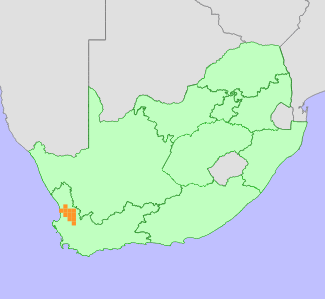|
Scientific Name | Sparaxis metelerkampiae (L.Bolus) Goldblatt & J.C.Manning |
Higher Classification | Monocotyledons |
Family | IRIDACEAE |
Synonyms | Sparaxis luteoviolacea Eckl., Sparaxis orchidiflora G.Lodd., Sparaxis variegata (Sweet) Goldblatt subsp. metelerkampiae (L.Bolus) Goldblatt, Synnotia metelerkampiae L.Bolus, Synnotia variegata Sweet var. metelerkampiae (L.Bolus) G.J.Lewis |
Common Names | Longtube Satinflower (e) |
National Status |
Status and Criteria | Near Threatened B1ab(iii,v)+2ab(iii,v) |
Assessment Date | 2021/09/16 |
Assessor(s) | P. Goldblatt, J.C. Manning, L. von Staden & T. Patel |
Justification | This species has an extent of occurrence (EOO) of 2766 km² and an area of occupancy (AOO) of 112 km². It is still a fairly common species, known to occur at between 16-20 locations. However, it is declining due to ongoing habitat loss to agricultural expansion. It almost meets criteria B to be classified as Vulnerable, and is therefore listed as Near Threatened. |
Distribution |
Endemism | South African endemic |
Provincial distribution | Western Cape |
Range | It is endemic to South Africa, and is found in Gifberg, Olifants River Valley and sandveld between Leipoldtville and Eendekuil in Western Cape. An early record from Oorlogskloof on the southern Bokkevle mountains requires confirmation. |
Habitat and Ecology |
Major system | Terrestrial |
Major habitats | Citrusdal Vygieveld, Cederberg Sandstone Fynbos, Olifants Sandstone Fynbos, Graafwater Sandstone Fynbos |
Description | It occurs in well-drained sandy and stony soil, always in well-drained situations. |
Threats |
| On the Gifberg, Olifants River Valley and in the sandveld, this species is threatened by ongoing habitat loss to agricultural expansion, predominantly for the cultivation of citrus, rooibos tea and potatoes. Thirty-five percent of sandy areas within its known range are currently irreversibly modified (calculated using landcover data in GIS). Many subpopulations however occur on rocky slopes unsuitable to ploughing, and this species' habitat is also well-protected within the western parts of the Cederberg Wilderness Area, where it is fairly common between Pakhuis Pass and Citrusdal. |
Population |
The population has an overall decreasing trend. In 1963, one of the subpopulations were recorded as abundant within a few patches. In 2002, it was common at one site. In 2007, it was recorded as locally abundant in a small patch at another site. It was fairly common on recently burned veld in 2010. One of the subpopulations observed in 2012 recorded less than 50 plants. Most recently, in 2015, it was recorded as fairly common on a south facing slope grading into forest.
|
Population trend | Decreasing |
Assessment History |
Taxon assessed |
Status and Criteria |
Citation/Red List version | | Sparaxis metelerkampiae (L.Bolus) Goldblatt & J.C.Manning | NT B1ab(iii,v) | 2015.1 | | Sparaxis metelerkampiae (L.Bolus) Goldblatt & J.C.Manning | Least Concern | Raimondo et al. (2009) | |
Bibliography |
Goldblatt, P. and Manning, J.C. 2000. Cape Plants: A conspectus of the Cape Flora of South Africa. Strelitzia 9. National Botanical Institute, Cape Town.
Goldblatt, P. and Manning, J.C. 2013. Systematics and biology of the Cape genus Sparaxis (Iridaceae). Strelitzia 32. South African National Biodiversity Institute, Pretoria.
Raimondo, D., von Staden, L., Foden, W., Victor, J.E., Helme, N.A., Turner, R.C., Kamundi, D.A. and Manyama, P.A. 2009. Red List of South African Plants. Strelitzia 25. South African National Biodiversity Institute, Pretoria.
|
Citation |
| Goldblatt, P., Manning, J.C., von Staden, L. & Patel, T. 2021. Sparaxis metelerkampiae (L.Bolus) Goldblatt & J.C.Manning. National Assessment: Red List of South African Plants version 2024.1. Accessed on 2025/11/22 |
 Comment on this assessment
Comment on this assessment

